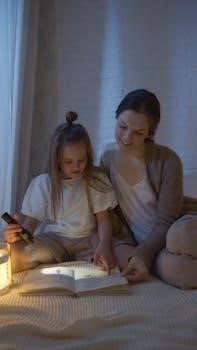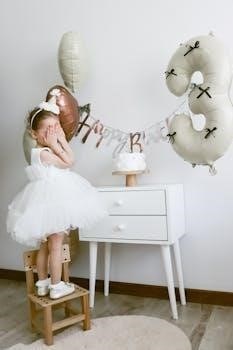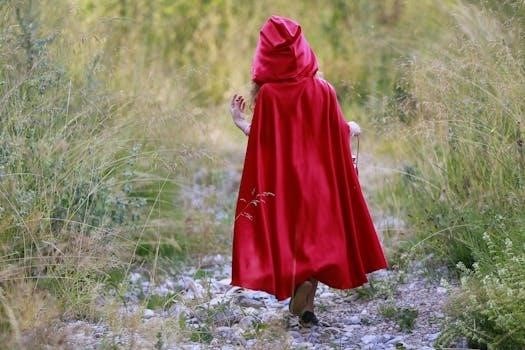
three little pigs story pdf
The Three Little Pigs⁚ Origins and Plot
The tale of the three little pigs is a classic folktale, with an early version featuring pixies instead of pigs and a fox as the villain. The well-known version appeared in 1890, in a book by Joseph Jacobs.
Traditional Story Elements
The traditional narrative of the three little pigs typically begins with a mother pig sending her three offspring out into the world to build their own homes. Each pig chooses different materials for construction, reflecting varied levels of effort and foresight. The first pig, opting for ease, constructs a house of straw. The second, a bit more industrious, builds his house with sticks. However, the third pig, showing wisdom and diligence, chooses to build a sturdy house of bricks. This difference in construction becomes a crucial element when the big bad wolf appears, seeking to devour the pigs. The wolf uses the repetitive phrases of huffing and puffing in attempts to blow down the houses, which ultimately highlights the contrast between the durability of the brick house and the fragility of the others. The story emphasizes themes of hard work, planning, and the consequences of choices, showcasing the importance of building a solid foundation, both literally and metaphorically.
Alternative Early Versions
Before the widely recognized version of “The Three Little Pigs” involving pigs and a wolf, there existed alternative early iterations of the tale. Notably, in one such version, the main characters were not pigs at all, but rather three little pixies. Furthermore, the antagonist in this variation was not the familiar big bad wolf, but a cunning fox. This substitution of characters indicates that the core narrative and its message were not strictly tied to the specific animal characters, and that the story has evolved over time. The shift from pixies to pigs and from a fox to a wolf illustrates the fluid nature of oral traditions, where stories adapt and change based on cultural preferences and storytelling practices. These alternative versions provide insights into the story’s development, demonstrating how a basic plotline can morph while retaining its fundamental theme of facing challenges and the importance of preparation and resilience, which is central to the story.

The Three Little Pigs⁚ Plot Breakdown
The narrative follows three pigs who leave home to build their own houses. Each pig constructs a house of different materials, and they soon face a hungry wolf trying to blow them down.
The Pigs’ Departure and House Building
The story begins with an old mother pig who decides her three little pigs are old enough to venture out into the world and build their own homes. She sends them off with a warning about the dangers of the big bad wolf. The first little pig, not inclined to hard work, quickly builds a house of straw. The second little pig, putting slightly more effort, constructs his house using sticks. Both of these houses are built quickly and without much consideration for strength or durability. The third little pig, however, understands the importance of a sturdy home, and he gathers bricks to build a strong, secure house. The pigs’ choices in building materials become crucial to the plot later on as they face the wolf’s attacks. Each pig has a different idea of what is important in a dwelling, and the story highlights the contrast of their approaches to this task.
The Wolf’s Attempts and Failures
The big bad wolf, hungry and determined to catch the pigs, begins his assault on their homes. He first approaches the straw house of the first little pig and demands to be let in. When the pig refuses, the wolf threatens to huff and puff and blow the house down, which he successfully does, devouring the pig. He then proceeds to the stick house of the second pig. With the same tactic, the wolf huffs and puffs, destroying the stick house and eating the second pig as well. However, when the wolf reaches the third little pig’s brick house, his huffing and puffing prove futile against the strong structure. His repeated attempts to blow it down are unsuccessful, leaving him frustrated and unable to get to the third pig.
The Brick House and the Wolf’s Demise
The third little pig, having wisely built his house of sturdy bricks, is secure from the wolf’s huffing and puffing. The wolf, unable to blow down the brick house, resorts to trickery. He tries to lure the pig out, but the pig outsmarts him. In some versions, the wolf attempts to enter through the chimney. The clever pig anticipates this and has a pot of boiling water waiting below. The wolf falls into the pot and is either boiled alive or runs away, never to bother the pigs again. This event marks the end of the wolf’s menacing presence, ensuring the safety and security of the three little pigs, especially the last one. The brick house becomes a symbol of strength and preparedness.

The Three Little Pigs⁚ Educational Applications
The story can be used in the classroom to teach story structure and character development. It is also excellent as a mentor text for young students, due to its classic narrative.
Teaching Story Structure
The narrative of “The Three Little Pigs” offers an excellent framework for teaching young learners about fundamental story elements. The sequential events, from the pigs leaving home to building their houses, clearly demonstrate a beginning, middle, and end. The story’s structure is simple and easy to follow, making it ideal for illustrating the concept of plot. Children can identify the problem, which is the wolf’s threat, and the rising action as he attempts to blow down each house. The climax occurs when the wolf is defeated, leading to the resolution where the pigs are safe. Furthermore, the repetitive phrases, such as “I’ll huff and I’ll puff,” help children understand how events build tension, contributing to a strong sense of narrative arc. This repetition also aids in memory and engagement, making the learning process more effective and fun. Teachers can easily use this story to introduce the concept of sequencing and predicting what will happen next, helping build essential literacy skills.
Developing Character Concepts
The story of “The Three Little Pigs” provides a wonderful opportunity to explore character traits and motivations. The three pigs themselves each represent different approaches to problem-solving and responsibility. The first pig, who builds a house of straw, is portrayed as lazy and lacking foresight. The second pig, opting for sticks, shows a slight increase in effort but still chooses an inadequate solution. The third pig, who builds a sturdy brick house, embodies diligence, planning, and intelligence. Through these contrasting characters, children can learn about the consequences of choices and the importance of hard work. The wolf, as the antagonist, offers a chance to discuss the concept of villainy and the motivations behind his actions. The use of repetitive dialogue, such as “Little pig, little pig, let me come in,” provides insight into the wolf’s persistent and menacing nature. Examining these characters aids in developing children’s understanding of empathy, perspective-taking and moral decision making.

Using as a Mentor Text
The enduring popularity of “The Three Little Pigs” makes it an ideal mentor text for various educational purposes. Its clear narrative structure, with a distinct beginning, middle, and end, serves as a model for young writers. The story’s straightforward plot allows students to easily identify the problem, rising action, climax, and resolution. Furthermore, the use of repetitive phrases and dialogue, such as the wolf’s “I’ll huff and I’ll puff,” can be used to teach about rhythm and language patterns. The story also offers opportunities to explore character development and descriptive language. Teachers can use the story to encourage students to create their own versions, changing the characters, settings, or plot. By examining how the author uses language and structure, students can learn to improve their own writing and storytelling abilities. The familiar nature of the tale helps to engage students and make learning more enjoyable and effective.

The Three Little Pigs⁚ Available Formats
The story of “The Three Little Pigs” is widely available in various formats, including PDF versions for digital reading and audio versions for listening, such as read-alouds.
PDF Versions and Digital Libraries
Numerous digital libraries and online resources offer free PDF versions of “The Three Little Pigs,” making the story easily accessible for both educational and recreational purposes. These digital versions often come with illustrations, enhancing the reading experience for children. You can find these PDFs on platforms like the Digital Library SJKC Chee Chuin, which published a version in 2021, and various free kids’ book websites. These PDFs allow for easy download and offline access, perfect for classroom use or reading at home. Many of these resources provide different versions of the story, some with variations in language or illustrations, allowing for a diverse experience. Some digital libraries also offer additional materials such as activities and worksheets to complement the story, making it a great resource for parents and educators looking for supplementary learning materials. The availability of the story in PDF format ensures that this classic tale remains accessible to all, regardless of location or access to physical books.
Audio Versions and Read-Alouds
Complementing the availability of PDF versions, many resources also offer audio versions and read-alouds of “The Three Little Pigs,” providing an alternative way to engage with the story. These audio formats are beneficial for auditory learners and younger children who may not yet be proficient readers. Audiobooks and read-alouds can be found on various platforms, including websites that host free kids’ audiobooks and educational resources. Some resources even provide accompanying music and sound effects, enhancing the immersive experience of the story. The use of different voice actors and pacing can make the story come alive in new ways, capturing the attention of children. Furthermore, audio versions are perfect for car rides, bedtime stories, or during quiet time, making it easy for children to enjoy the story at any time. These read-alouds are also helpful for ESL learners and those who benefit from hearing the story read aloud, supporting literacy development.
Leave a Reply
You must be logged in to post a comment.